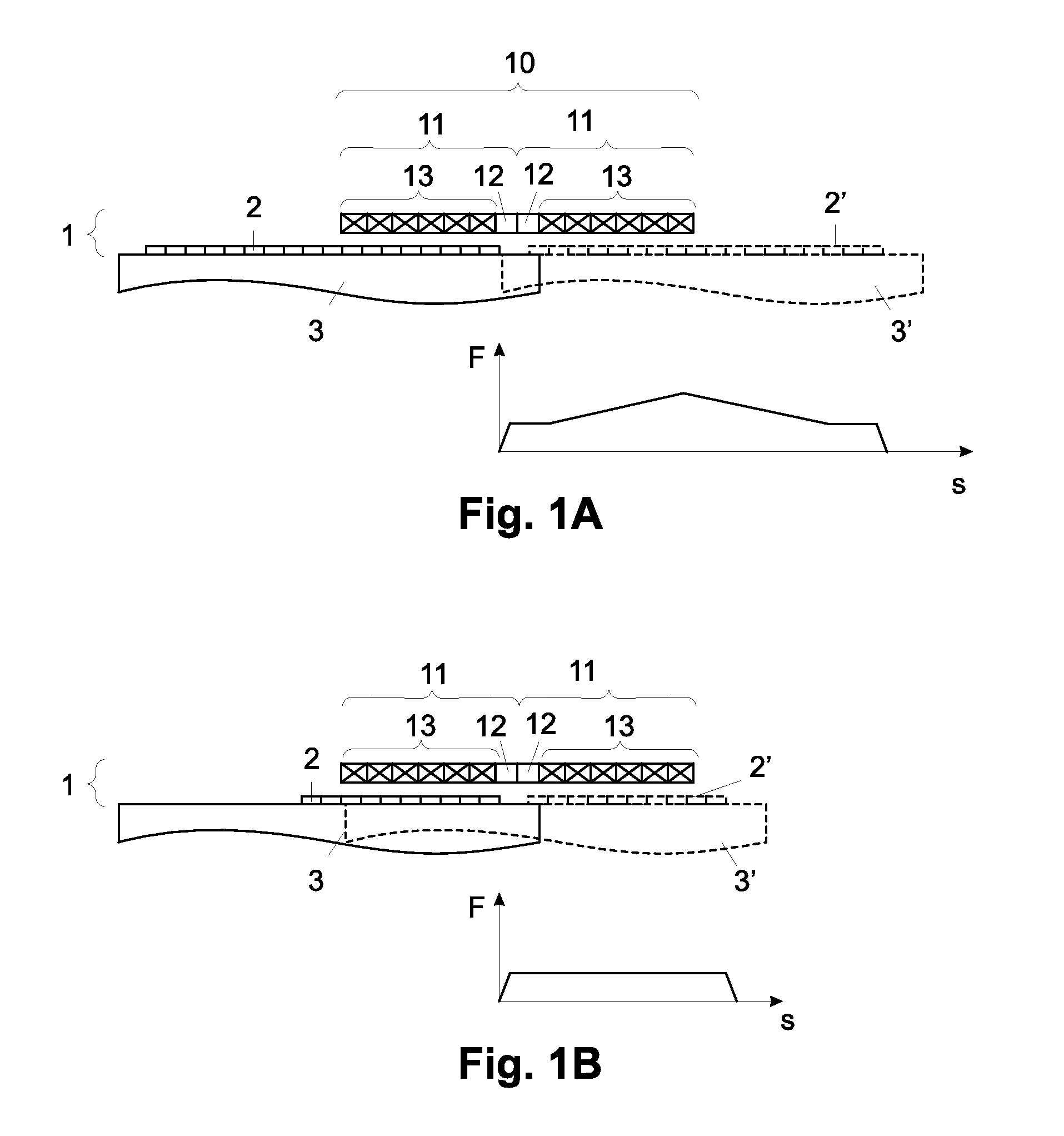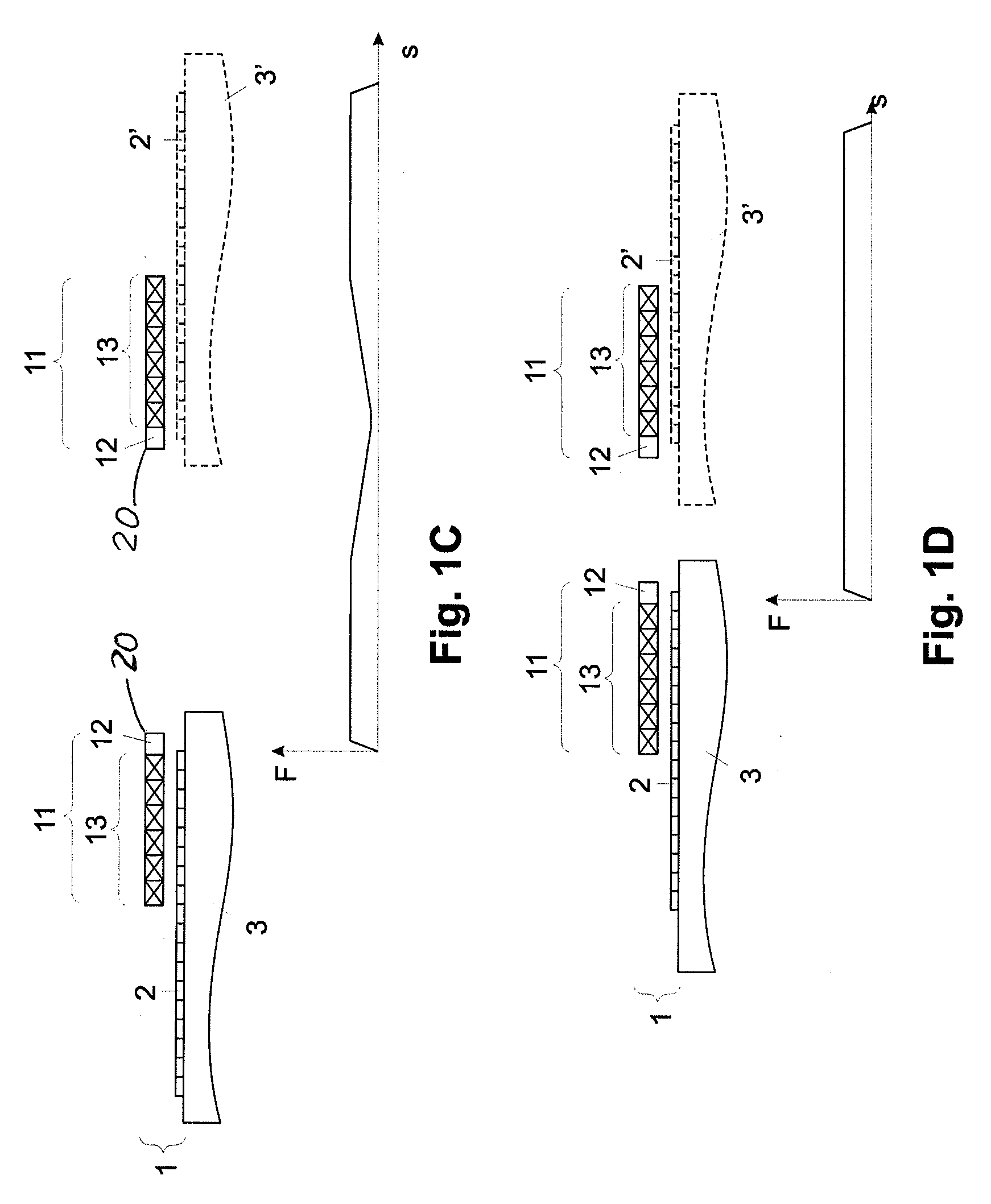Arrangement of Stator Modules in a Linear Motor
- Summary
- Abstract
- Description
- Claims
- Application Information
AI Technical Summary
Benefits of technology
Problems solved by technology
Method used
Image
Examples
first embodiment
[0030]According to the invention shown in FIG. 1A, stator modules 11, 11 preferably each have a coil arrangement 13 and a displacement sensor 12 and, for illustration purposes, the stator modules 11, 11 have the same structure. The displacement sensors 12, 12 are configured at ends of the stator modules 11, 11 facing each other. The stator modules 11, 11 extend respectively along an area of an exemplary linear travel path of the panel to be moved 3 in the area of the respective stator module 11. In the arrangement shown, the stator modules 11, 11 abut against each other, i.e. they have a very small distance to each other or they do not have any distance at all. Preferably, a shape of a respective stator module 11, seen in longitudinal extension, follows a course of the travel path of the panel to be moved 3 in the area of the respective stator module 11.
[0031]A diagram, illustrated on the bottom of FIG. 1A, diagrammatically shows a characteristic of a driving force F of the linear m...
second embodiment
[0044]An arrangement shown in FIG. 2A according to the invention differs from the arrangement shown in FIG. 1A in that the displacement sensors 12, 12 are configured at ends of the stator modules 11, 11 facing away from each other. As the stator modules 11, 11, practically do not have any distance to each other, the stator modules 11, 11 virtually form a single stator module 11, which, at both ends, has respectively one displacement sensor 12 with a coil arrangement 13 disposed therebetween.
[0045]When the rotor 2 begins to move, it gradually enters more and more interaction ranges of coils of initially the left and then also the right coil arrangement 13, 13, which results in an increase of the driving force F of the linear motor 1 and thus of the speed of the rotor 2. Thereupon, as long as the rotor 2 is located in the interaction range of all coils of both the left and the right coil arrangement 13, 13, the driving force F of the linear motor 1 remains almost constant. From a pred...
third embodiment
[0049]An arrangement according to the invention shown in FIG. 3A differs from the arrangement shown in FIG. 1A in that the right stator module 11 is disposed rotated about 180° such that the left stator module 11, with its displacement sensor side end, is disposed to face a coil side end of the right coil arrangement 13.
[0050]When the rotor 2 starts to move, all coils of the left coil arrangement 13 are in interaction with the rotor 2, which results in the increase in driving force F of the linear motor 1 illustrated in the diagram in FIG. 3A. As long as the rotor 2 is not yet located in the interaction range of the right coil arrangement 13, the driving force F remains essentially constant. When the rotor 2 enters the interaction range of the right coil arrangement 13, the driving force F increases gradually up to a maximum, as long as the rotor 2 is still located in the interaction ranges of all coils of the left coil arrangement 13. In the meantime, the rotor 2 gradually enters t...
PUM
 Login to View More
Login to View More Abstract
Description
Claims
Application Information
 Login to View More
Login to View More - R&D
- Intellectual Property
- Life Sciences
- Materials
- Tech Scout
- Unparalleled Data Quality
- Higher Quality Content
- 60% Fewer Hallucinations
Browse by: Latest US Patents, China's latest patents, Technical Efficacy Thesaurus, Application Domain, Technology Topic, Popular Technical Reports.
© 2025 PatSnap. All rights reserved.Legal|Privacy policy|Modern Slavery Act Transparency Statement|Sitemap|About US| Contact US: help@patsnap.com



